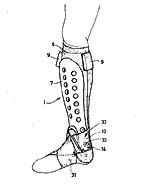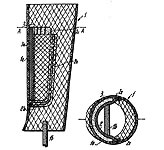Shin Guards
2. Fastening of shin guards to the players' legs

![]() Figure 3a: Shin guard for insertion into the sock, featuring a plurality of foam strips adhered to a tear-proof fabric with skin-friendly, non-sliding adhesive layer (DE 1 998 446 U1)
Figure 3a: Shin guard for insertion into the sock, featuring a plurality of foam strips adhered to a tear-proof fabric with skin-friendly, non-sliding adhesive layer (DE 1 998 446 U1)
Initially, shin guards were fastened to the players' legs by means of belts. This method did not only impair the free movement of the leg but also reduced blood circulation in the calf area and led to early fatigue and cramps.
An early British patent specification (GB 1886-2678) proposed to hold shin guards in place by means of elastic springs to avoid cutting off circulation in the wearer's calves.
The easiest way, avoiding straps or lacing, is to put the shin guard into the socks. The drawback of this solution is that these shin guards will easily slide on legs wet with perspiration. To avoid this inconvenience, the inside of the shin guard is usually coated with a gripping layer so that the shin guard will not slip out of the sock (Figure 3a).

![]() Figure 3 b: Shin guard with anatomically shaped shell and two extensions (12) protecting the ankle and preventing the shin guard from sliding (DE 23 10 149 A)
Figure 3 b: Shin guard with anatomically shaped shell and two extensions (12) protecting the ankle and preventing the shin guard from sliding (DE 23 10 149 A)
Other shin guards have fork-like extensions at the lower end which cover the ankles (Figure 3b). These shin guards are less prone to lateral sliding and additionally protect the ankle from blows (cf. section 4).
The grip of socks/stockings/gaiters to the legs is a general problem. Wet, slipping gaiters, above all, will not retain shin guards sufficiently in position, so that the shin guards will easily slip out despite a gripping layer. It was therefore proposed to incorporate shin guards into the socks or to insert them into specifically provided pockets (Figure 4). These solutions will only work if the socks fit well and tightly to the legs, which cannot always be guaranteed, especially under wet weather conditions.
Furthermore, cleaning and care of such reinforced and mostly expensive socks are comparably cumbersome.
Owing to these difficulties, the most popular fastening method still consists in attaching shin guards by means of flexible calf straps. In the early days of football, laced or buckled straps were typically used for fastening shin guards. A maybe somewhat cumbersome solution had been drawn up in the 1920s. It consisted of two longitudinal shin-guard halves reinforced on both sides by means of celluloid or steel bars. The parts were laced together at the front and fastened to the wearer's leg by two calf straps.
Flexible calf straps provide easy to remove and adaptable fastening solutions. The previously used buckles have been replaced by hook and loop fasteners.

![]() Figure 5: Shin guard featuring a protective shell (1) clipped onto a padded gaiter (2) (DE 297 05 759 U1).
Figure 5: Shin guard featuring a protective shell (1) clipped onto a padded gaiter (2) (DE 297 05 759 U1).
A very popular solution for fixing a shin guard consists in the following: a gaiter-type component is placed around the ankle area so that only one calf strap is required to hold the protective shell in place. Apart from being placed in pockets, protective pads or shells can be attached by means of slip-on or clip-on solutions (Figure 5). Again, cleaning and care must be considered. The detachable fastening of rigid shells on soft fabric gaiters offers significant advantages.
Most recently, shin guards were proposed, in which a protective plate with spiral springs is attached to a leg protection cover (DE 10 2011 052 970 A1).
The self-holding shin guard GB 2 484 570 A1 should do completely without socks or belt.
GB 2 506 414 A is a further development of the sock with integrated shin guard and additional fastening element.
DE 20 2016 101 863 U1 makes improvements to a neuralgic point of the shin guard, the anti-slip material on the inside and fixing surfaces on the outside.
| Publication number | Year | Title | Brief description |
|---|---|---|---|
| DE 297 05 759 U1 | 1997 | Schienbeinschützer zur Anbringung an ein Schienbeinpolster | Shin guard featuring a protective shell clipped onto a padded gaiter |
| DE 27 43 741 A1 | 1977 | Strumpf, insbesondere Kniestrumpf | Sock provided with a pocket for receiving a shin guard |
| US 4,001,953 A | 1977 | Protective Gaiter | Gaiter-type shin guard |
| DE 76 28 988 U | 1976 | Schienbeinschützer | Shin guard shell attached to the lower leg by means of two straps with hook and loop fasteners |
| DE 76 05 625 U | 1976 | Unterschenkelschützer | Protective device with two pads, for the front and rear parts of the lower leg, attached by means of hook and loop fasteners and thus secured jointly around the lower leg (see section 4) |
| DE 23 10 149 A | 1973 | Unterschenkelschützer | Shin guard consisting of anatomically shaped shell provided with two extensions covering the ankle to protect the ankle and maintain the shin guard in position. |
| DE-GM 1 998 446 | 1968 | Schienbeinschützer | Shin guard made of a plurality of foam strips adhered to a tear-proof fabric with skin-friendly, non-sliding adhesive layer |
| CH 400 052 A | 1965 | Strumpf mit Schienbeinschoner | Gaiter-type shin guard where the shell is placed in a pocket (concept similar to DE-GM 1 779 734, which provides an illustration with more details) |
| DE-GM 1 779 734 | 1958 | Fußballstutzen mit Schienbeinschützer | Gaiter-type shin guard where the shell is placed in a pocket |
| DE-GM 1 719 698 | 1955 | Schienbeinschützer | Shin guard with a plurality of parallel tube-shaped protective elements arranged on a base plate whose backside is coated with a skin-adhesive foam or sponge layer (see section 3) |
| DE-GM 1 606 741 | 1950 | Schienbeinschützer | Shin guard with ankle tongues to prevent guard from sliding onto the ankle joint (regrettably, no illustration provided) |
| US 2,553,612 A | 1948 | Self-Grip Waterproof Distributing Shin Guard | Shin guard with hard rubber shell and sponge rubber strips at the inner face |
| DE-PS 548 786 | 1930 | Schienbeinschützer für Sportzwecke, insbesondere für Fußballspieler | Well-known shin guard with outer curved steel plate and soft inner rubber layer, in analogy to DE-PS 458 365 (see section 1), featuring quick adjustable straps which are easily loosened |
| DE-PS 382 722 | 1922 | Schienbeinschützer für Fußballspieler | Shin guard consisting of two longitudinal halves, reinforced by means of celluloid or steel bars, laced together at the front and fastened to the wearer's leg with two calf straps |
| DE-PS 345 283 | 1921 | Schutzvorrichtung für das Schienbein | Shell protecting the shinbone, fastened to the lower leg by means of two small belts |
| GB 1886-2678 | 1886 | Improvements in Leg-guards for Cricket, Football, and similar Games | Early shin guard whose shell is held in place by two elastic springs embracing the wearer's calves |

